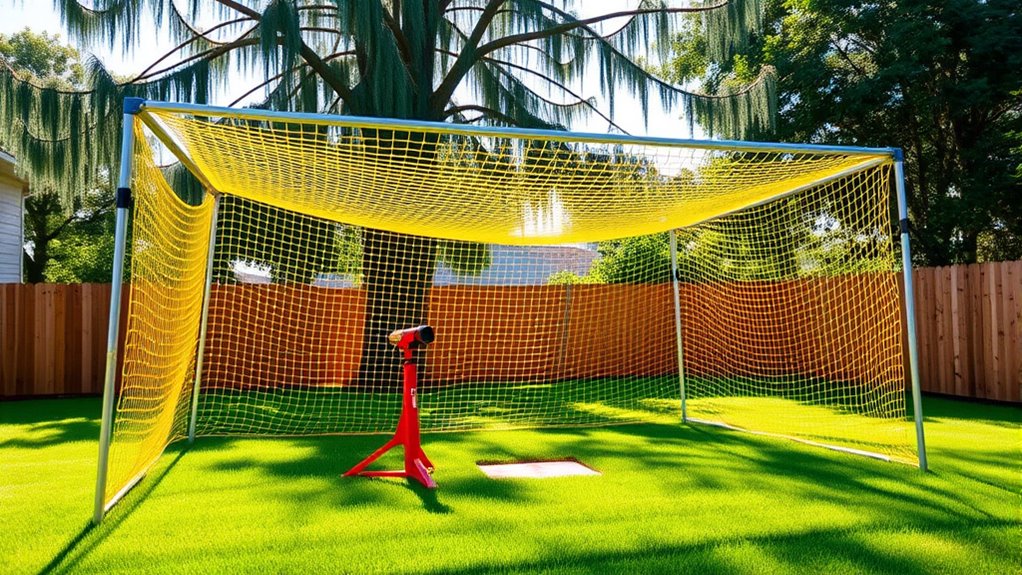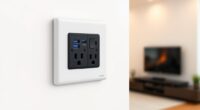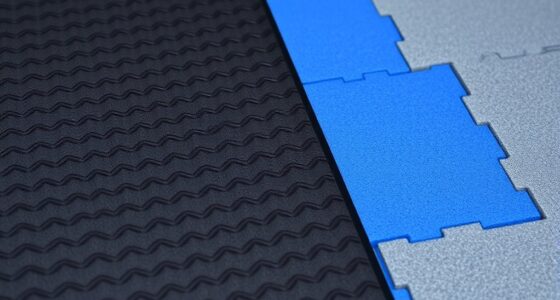To install a backyard batting cage, start by planning the size and gathering durable materials like 2×6 lumber and 4×4 posts. Mark your site, dig foundation holes, and pour concrete to secure sturdy corner posts. Assemble the frame with crossbars and add the net, ensuring it’s tightly secured and adjustable. Finish by laying a proper ground surface and adding safety accessories. If you follow these steps carefully, you’ll create a safe, functional batting cage — keep exploring to learn more.
Key Takeaways
- Measure and plan the cage size, ensuring it fits your available backyard space and complies with local regulations.
- Prepare a sturdy foundation with concrete footings and anchor posts securely into the ground.
- Assemble the frame using durable materials like 2×6 lumber and 4×4 posts, ensuring structural stability.
- Install the net securely with pulleys, hangers, and carabiners, and adjust tension for safety and performance.
- Add a suitable ground surface, such as gravel or artificial turf, and include safety accessories like backstops and screens.

Thinking about boosting your backyard baseball practice? Installing a batting cage is a great way to improve your skills right at home. First, you’ll need to plan and prepare carefully. Start by determining the right size for your space. A typical setup might measure around 12 feet wide, 12 feet deep, and extend about 55 feet long to give you enough room for full swings. Measure your available area and make sure these dimensions fit comfortably. Next, select materials that are durable and suitable for outdoor use. Use 2×6 lumber for the frame and 4×4 posts for the corner supports. Planning your layout with a 3D design program helps visualize the structure, minimize material waste, and reduce labor.
Once you have your plan, gather all necessary equipment, including tools like a post hole auger and concrete mixer. Before digging, check local building codes and regulations to make certain your project complies with neighborhood rules. Mark the layout on the ground with stakes and string to make sure everything lines up perfectly. Use a post hole auger to dig holes for your corner posts, and set concrete forms in each hole to hold the posts securely. Fill the forms with concrete and insert anchor bolts for attaching the posts later. Allow the concrete to set for at least 24 hours before proceeding.
When the foundation is solid, cut your wood posts to size if needed. Use half lap joints where necessary to improve stability. Assemble the frame by securing eight posts with four runners and three crossbars, creating a sturdy rectangular structure. Attach the post bases to the concrete with anchor bolts, and add support braces for extra strength. Connect the runners and crossbars tightly to make sure the frame is solid.
Choosing the right net is vital. Pick a durable net that matches your cage’s size, and prepare attachments like carabiners and pulleys for easy installation and adjustments. Consider including a net door to facilitate access. Lay the net inside the frame, then secure it with net hangers and carabiners at the top. Thread the hangers through pulleys to make raising and lowering the net simple. Attach the bottom of the net to ground sockets or stakes for stability, and use turnbuckles to tighten the net for a snug fit.
For the floor, prepare a subbase of gravel or sand to aid drainage. Lay artificial turf or a similar surface that can withstand batting practice, securing it with stakes or adhesive. Make sure the turf is laid evenly for a smooth hitting surface, and regularly inspect and clean it to maintain quality.
Finally, add accessories like backstops and L-screens for protection. Test all components to make certain everything functions properly and securely. With careful planning and execution, you’ll have a professional-quality batting cage in your backyard ready for endless practice sessions. Ensure you verify the measurements of all components before final assembly to maintain proper alignment and safety.
Frequently Asked Questions
What Is the Average Cost of Installing a Backyard Batting Cage?
The average cost of installing a backyard batting cage typically falls between $1,200 and $6,000, depending on size, materials, and whether you hire professionals or do it yourself. You can expect to pay more for larger, premium systems with features like lighting and pitching machines. Keep in mind that costs vary based on your choices in netting, frame materials, and installation complexity. Planning ahead helps you stay within your budget.
How Much Space Is Needed for Different Cage Sizes?
Think of space for a batting cage like fitting a giant puzzle piece into your yard. For shorter cages around 20-35 feet, you need about the length of a small car. If you’re aiming for longer cages over 55 feet, plan for a space roughly the size of a garage. Widths of 12-14 feet require comparable room, and a 12-foot height guarantees safe, comfortable swinging without hitting the ceiling.
Are There Any Local Permits Required for Installation?
You should check if local permits are necessary before building your batting cage. Requirements vary depending on your location, cage size, height, and proximity to property lines. Contact your city’s planning or building department to confirm rules and obtain permits if needed. Also, review your homeowners association rules. Skipping this step can lead to fines or having to dismantle your cage, so it’s best to verify everything upfront.
What Safety Measures Should I Consider During Setup?
When considering safety measures during setup, you should first clear the area of debris and obstacles, guaranteeing a safe working space. Level the ground to prevent uneven surfaces, and secure the frame with sturdy anchors like concrete footings or auger anchors. Regularly inspect the stability of the cage, and use high-quality clips and ties to attach the net securely. Always follow manufacturer instructions to prevent accidents and guarantee safety.
How Do I Maintain and Clean the Batting Cage Regularly?
To keep your batting cage in top shape, you should regularly inspect it for wear and damage. Clean the netting with a soft brush and fix small tears immediately. Lubricate moving parts monthly, remove debris, and apply UV protection. During bad weather, clear snow and ice, and temporarily remove the netting if necessary. Store components properly in dry, rodent-proof containers during off-season to prevent rust and damage.
Conclusion
Now that you’ve installed your backyard batting cage, you’re officially the king or queen of home baseball! Every swing sends a thunderous crack that echoes through the neighborhood, turning your yard into the grandest stadium on Earth. With just a few steps, you’ve created a legendary training ground where future all-stars are born. Get ready to hit home runs so big, they’ll shake the clouds and make history—your backyard is now the ultimate baseball fortress!









